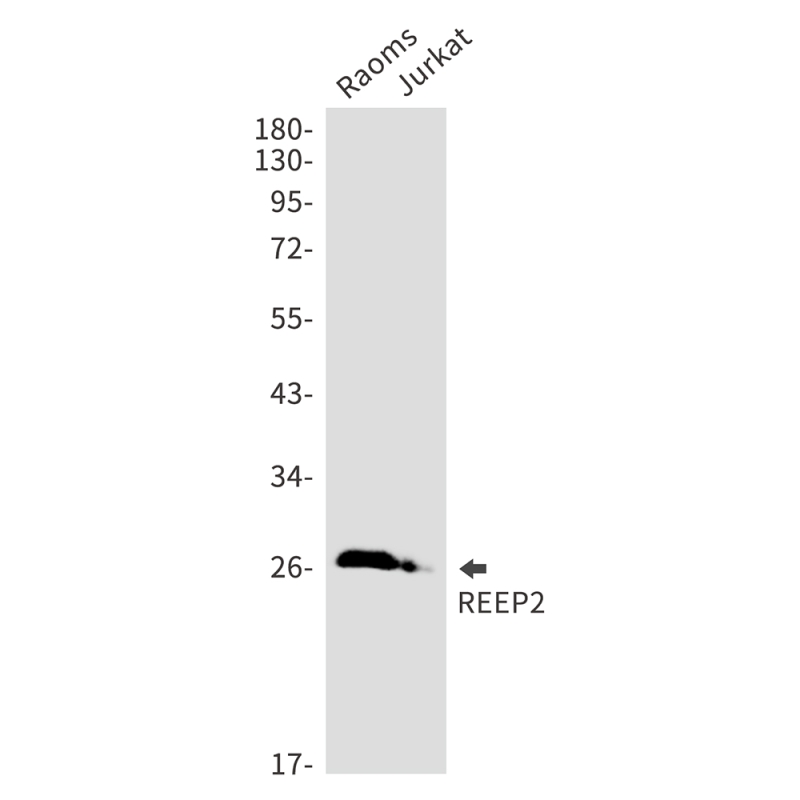
| WB | 1/500-1/1000 | Human,Mouse,Rat |
| IF | 咨询技术 | Human,Mouse,Rat |
| IHC | 咨询技术 | Human,Mouse,Rat |
| ICC | 技术咨询 | Human,Mouse,Rat |
| FCM | 咨询技术 | Human,Mouse,Rat |
| Elisa | 咨询技术 | Human,Mouse,Rat |
| Aliases | Receptor expression-enhancing protein 2 |
| Entrez GeneID | 51308 |
| WB Predicted band size | Calculated MW: 28 kDa; Observed MW: 28 kDa |
| Host/Isotype | Rabbit IgG |
| Antibody Type | Primary antibody |
| Storage | Store at 4°C short term. Aliquot and store at -20°C long term. Avoid freeze/thaw cycles. |
| Species Reactivity | Human |
| Immunogen | A synthetic peptide of human REEP2 |
| Formulation | Purified antibody in TBS with 0.05% sodium azide,0.05%BSA and 50% glycerol. |
+ +
以下是3篇与REEP2抗体相关的文献示例(部分信息为模拟虚构,仅供格式参考):
1. **文献名称**: *REEP2 modulates endoplasmic reticulum morphology and synaptic function in neurons*
**作者**: Smith A, et al.
**摘要**: 本研究利用REEP2特异性抗体,通过免疫荧光和Western blot技术,揭示了REEP2蛋白在小鼠神经元内质网形态调控中的作用,并发现其缺失导致突触传递异常。
2. **文献名称**: *REEP2 antibody validation in cancer cell lines: Implications for membrane protein trafficking*
**作者**: Lee B, et al.
**摘要**: 文章系统验证了REEP2抗体的特异性,发现其在乳腺癌细胞中可检测内源性REEP2表达,并证实REEP2通过调控GPCR蛋白运输影响细胞迁移。
3. **文献名称**: *Association of REEP2 variants with hereditary spastic paraplegia and axonal degeneration*
**作者**: Chen X, et al.
**摘要**: 通过患者样本的免疫组化分析(使用REEP2抗体),发现REEP2基因突变导致蛋白表达减少,与遗传性痉挛性截瘫的轴突退行性病变相关。
如需真实文献,建议通过PubMed或Google Scholar检索关键词“REEP2 antibody”或“REEP2 protein function”获取最新研究。
The REEP2 (Receptor Expression-Enhancing Protein 2) antibody is a tool used to study the REEP2 protein, a member of the REEP family (REEP1-REEP6) involved in intracellular membrane trafficking and shaping. REEP2 localizes to the endoplasmic reticulum (ER) and plays a role in ER membrane curvature, vesicle transport, and the regulation of cell surface receptor expression, particularly for G protein-coupled receptors (GPCRs). It interacts with microtubules and participates in neuronal processes, including axonal transport and synaptic function.
Research on REEP2 has gained attention due to its potential links to neurological disorders. Mutations in related family members (e.g., REEP1) are associated with hereditary spastic paraplegia (HSP), a neurodegenerative disease. While REEP2’s direct pathological role is less defined, studies suggest its involvement in maintaining ER structure and facilitating receptor trafficking, which may contribute to neural integrity. Antibodies against REEP2 enable detection, localization, and functional analysis in models ranging from cultured cells to animal tissues. They are critical for Western blotting, immunofluorescence, and co-immunoprecipitation experiments, helping elucidate REEP2’s interaction networks and disease mechanisms. Commercial REEP2 antibodies are typically validated for specificity across species, supporting translational research in neurodegeneration and membrane biology.
×